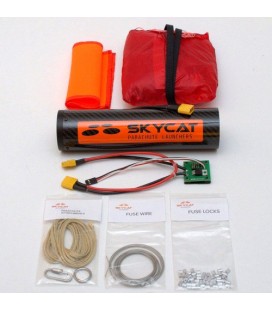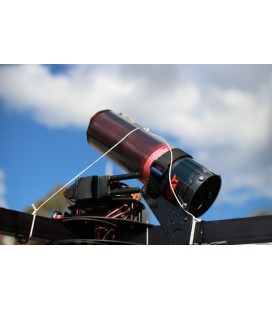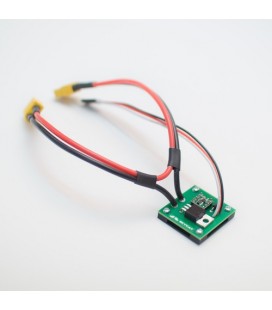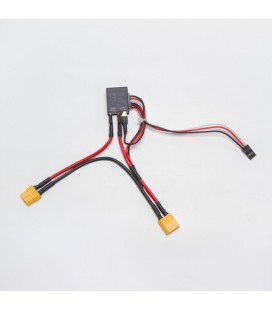No products
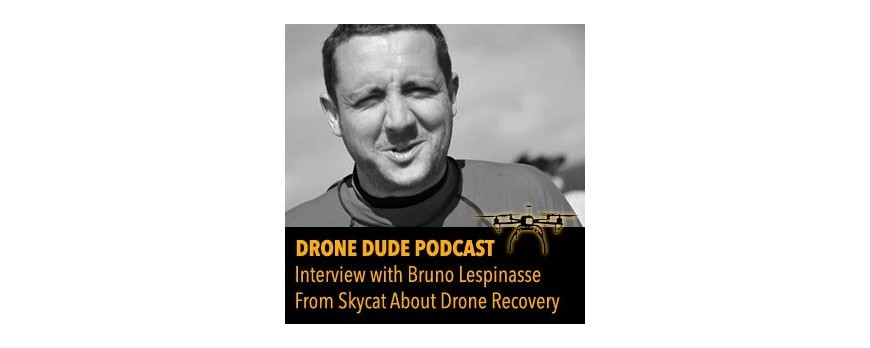
Bruno Lespinasse from Skycat on drones, parachutes and legislation
This is a transcript of the podcast "Interview with Bruno Lespinasse From Skycat About Drone Recovery Systems" from dronedudepodcast.com.
Description :
Bruno Lespinasse talks to us about drone recovery systems, including his company's parachute system. We also talk about the state of the drone industry in various countries including US, Finland and France and how legislation in these countries will affect the future of commercial droning.
Marcelo Lewin : Hello and welcome to the dronedudepodcast, I am your host Marcelo Lewin. Today my guest is Bruno Lespinasse from Skycat which create a parachute safety system for drones. Bruno, welcome to the dronedudepodcast.
Bruno Lespinasse : Thank you.
Marcelo Lewin : Why don't we start up by you giving us a quick overview of your background and how you got into drones ?
Bruno Lespinasse : I moved from France to Finland and started to work for a small company where we are making packing machines and one of my colleagues was a RC hobbyist he had many planes for quite a long time I've been a radio controled models too and we started to fly together and to exchange ideas on everything and he started to buy cameras to put the cameras on the planes and from that he actually built a quadcopter and put a camera on it and that's how we got into drones and then that developped into this parachute thing.
Marcelo Lewin : What attracted you to drones versus let's say helicopters or sticking with planes ?
Bruno Lespinasse : I'm still not a pure drone enthusiast. i'm still flying planes and helicopters.I like the idea of drones, I think they can help in many industries and for many businesses. I thinks they are much more usefull than they do arm and I'd like to work for this. Now personally I don't really fly drones so often.
Marcelo Lewin : So what's the attitude in both France and Finland toward drones ?
Bruno Lespinasse : Globally I think people sees drones as killing machines. They've seen them operating in Iraq and Afghanistan And that's what they've seen first on TV, so when you talk about drones the first idea that comes up in their mind is that drones are killing machines
Now what we see is that the technology is getting better and better day by day and the legislation and the risk behind flying drones especially in the cities. The legislation is too late they are now reacting too thing that happened basically a few years ago so we still have a situation where it's fairly free to fly, in Finland for example you can fly commercially and perform some jobs with drones. But we know that the legislation is going to get tougher. The good example of this is France : France was one of the first countries to have legislation about drones and they actually made a pretty good job. I think a lot of people in the business recognize that they (the DGAC, Direction Générale de l'Aviation Civile, French aviation authority) did more good than bad, because at least we have a framework where we know... what is legal and what is not. And they went really deep into the details : different scenarios, depend if you're flying above people or not, if you're flying in the city or not, if you’re flying out of sight or if you still have a visual contact with your drone and they have set different limits to what you can do and you need to ask for a permission from the authorities which still is a problem for the operators because it takes a lot of time and then if you get the permission you can do the job
Marcelo Lewin : And that's part of the problem here in the states as we are far behind, basically commercial droning is completely prohibited hopefully that will change soon but we'll talk more about that in a minute but today we're trying to talk about safety and you guys built sort of a parachute system. Which seem to be the trend. I know Hubsan at CES announced their new one, which has a built-in parachute, but your system is for all other drones that don't have parachutes. So maybe we can tell us a bit about Skycat and the parachute launchers.
Bruno Lespinasse : Yeah sure. Skycat was founded by my colleague Henry and he did that because of his own experience. he was flying quadcopters with more and more expensive cameras and he started to think like "Wow ! If this comes down, I will lose a lot of money !". So he started to look into parachute systems. Or any recovery system that could exist and he couldn't find much he was not really convinced by what he found on the Internet. And one day he lost control, actually he had lost a propeller and the quadcopter went down from 150 meters and it was completely destroyed. Afterward he started to think : ok I lost the camera, I lost the ?, I lost the copter but he started to think like "that could have fall on somebody, that could actually kill someone".
From that day he couldn’t fly anymore, he was thinking about safety in a different way and he started to work on the parachute system, because he didn't want to fly anymore without a recovery system. He started to develop his own and that's where I came in because we are exchanging ideas all the time. He was publishing on diydrones.com as well, different ideas and different tests, he was putting a lot of videos and got input from colleagues and form people who actually became our test pilots. And we started from a few things we knew : we didn't want any explosive, we think they are dangerous during manipulation and storage, it's actually forbidden to fly with them, so we didn't want any ignition or any explosive in the system. We wanted something simple that would be really light because anything you add on the copter is out of the payload. that's a fairly big problem for small drones. SO we thought like spring load would be the best and then we just needed to find a trigger that would be really quick and we started to work on this and we found a solution, we actually patented it and today that works really well. I think the biggest difference between our system and what existed before is that everything that was made before was based on... I would say the human parachutist safety chutes where you have somebody or something falling like 30 or 40 m/s and you just need to extract the parachute, you actually just need to pull the parachute out of a bag and it will deploy by itself because of the speed. If you look at the drone problem, you can be actually hovering like 20 meters above ground and if you lose a motor or lose control of the drone. It's going to fall. But it's not falling that fast. The big thing in what you want to do is that you want to deploy the parachute before you actually reach any speed. And that's why we really need some ejection system that would be strong enough to shoot the parachute until the lines of the parachute are going to deploy the parachute by himself. So, it's not relying on the speed, you don't need to be in free fall for 10 seconds before you pull it out. You can just shoot it out basically even in a stationary position, not moving at all and it will still deploy. And we did many many tests, I mean we have been testing that for more than 6 months, I don't know how many hundred flight, in all different positions, with the drone spinning, falling upside down. We managed to find the right set-up where it will deploy every time.
Marcelo Lewin : Is this deployed by the pilot or is it deployed automatically or can you do both ?
Bruno Lespinasse : Basically I would say it's up to you. So far what we are using most of the time is a trigger that is remotely activated by the pilot himself through the same radio.
Marcelo Lewin : So that means it requires a channel right for that, right ?
Bruno Lespinasse : Yes absolutely. What you can do is actually use a different radio and a different receiver to make sure you have perfect redundancy. So if you lose control because your radio is dead, you have a second radio to actually shoot the chute out. Now you can connect that same input that is going to trigger the ejection system, you can connect that input to any flight control system. And you can decide like with this kind of acceleration then I will deploy the chute automatically. it's quite a freaky thing to do because depending on how you fly, some normal parts of your flight path could actually eject the parachute. Which is definitely something you don't want to do. So the decision making of how the chute is coming out is the key thing.
Marcelo Lewin : So do you plan on adding a box or anything that allows you to program it ?
Bruno Lespinasse : Yes, we are definitely working on that. It's not going to be only on the sensors or how many sensors but how you treat the information. And what we want to do is to provide the system that can make the drone safe today through triggering with the radio people are using today. I think the automatic trigger is coming later but what we need to have is an ejection system and parachute for all the drones on the market today. If that would available then people would make the decision whether they want to fly without or to make sure they’re safe.
Marcelo Lewin : Drones are really easy to fly and people think they can just turn it on and go flying and they really don't think that these things can fall. Not only to break and lose thousand dollars potentially of equipment but you can, if not kill, you can definitely hurt somebody. So what are some safety tips that you can provide to people that just got their drone for Christmas ?
Bruno Lespinasse : I think the first question is : where are you going to fly ? If you're flying in a completely deserted area with basically nothing to hit, I think the risk is quite low. And then you can start to test your material, see how the drone is behaving and what happens when it's not going the way you want. I think this is really important to test and to know the machine.
The second thing you need to check is whatever you do you need it is legal. I think flying in a populated area can be really dangerous and flying over people is a really bad idea. So I think this is probably the most important.
The third one is going to be : what do you do if tit goes wrong, what is going to happen if it goes wrong. So basically you have to simulate all the possible situations and at least think about what you would do in that situation. I think redundancy in the copter can help a lot, if you have a hexacopter and you can fly with only five motors then of course it gives you a little bit more time to let and do something. If you have two batteries instead of one you may actually land safely even if one battery is dead. I think redundancy is really important. The other is that, when something bas happens that you have thought about, what you're going to do, how you're going to react to that situation. And this is where the parachute comes in because in the last case if you can't land and you have lost the control and there's nothing you can do anymore then you can pull the parachute and at least make sure that, you cannot control where the drone is falling but you can make sure that it's going to fall slower and reduce a lot the damage at the impact.
Marcelo Lewin : Yeah, those are great tips. How do you see the ease of commercial drones evolving ?
Bruno Lespinasse : I think so far from what I've heard on the market it's mainly video shooting and taking pictures and second coming up is probably checking some installations, some power lines or stuff like that. These are the most common today. but of course depending on the legislation. At he some point we actually get a legislation that make the automatic flight modes possible. So that the drone would fly without any pilot, they would just go from point A to point B following their GPS and there wouldn't be any pilot anymore. then I think the sky's the limit and this is the case. Anything could be imagined. the Amazon and the Google project are really interesting in this matter. I still think it depends on the legislation because so many countries are actually working on that legislation. We know that the new bill is going to pass in Finland and more than 5 kilos drones will have to be equipped with a system that reduce the energy at the impact so that means a parachute. In France it's already the case for the 4 kilos class. So we know if legislations makes the safety features compulsory but allows the use of the drones, then we will have an industry.
Marcelo Lewin : Definitely an exciting time for drones. Well Bruno unfortunately we are completely out of time. I do want to thank you for joining me here today.
Bruno Lespinasse : Thank you, thank you for having me.
Marcelo Lewin : If people want to get in touch with you or learn more about Skycat, where should they go ?
Bruno Lespinasse : They should go to Skycat.pro this is our website and it gathers all the explanations about the technology and the origins of the project and all the contacts of the team.
Marcelo Lewin : Well thanks again Bruno and to the rest of you remember to checkout the dronedudepodcast.com to listen to more episodes of this podcast and remember to follow @thedronedude on Twitter. So until the next episode I am your host Marcelo Lewin. Cheers everyone.
Leave a CommentLeave a Reply
Blog archives
Featured Products
Latest Comments
-
POPPRE Zoltan
on Parachutes, DGAC, drones and S3 scenario - New... -
Marchico Robert
on Rescue parachutes for multirotor drones -
Gaël Billon
on Automatic parachute deployment with Pixhawk -
Gaël Billon
on Automatic parachute deployment with Pixhawk
Blog search
New products
No New products


